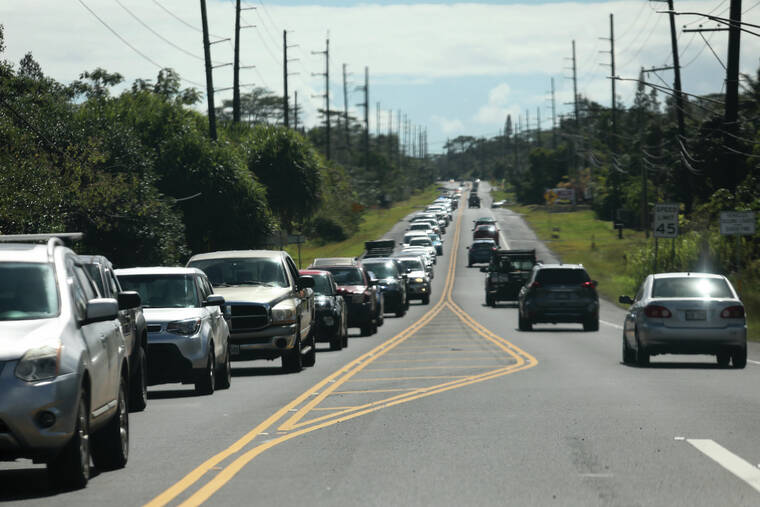The Hawaii County Council is urging the Legislature to take steps to improve ailing roadway infrastructure on the Big Island.
At Tuesday’s meeting of the Committee on Government Operations, Relations and Economic Development, council members discussed a pair of nonbinding resolutions encouraging action from state lawmakers.
The first resolution requests that the Legislature allocate resources to improve roads in Puna, while the second asks that the state allow a county to use a percentage of the general excise and fuel taxes it generated to maintain private roadways that are used by the public.
The first resolution was presented by Puna Councilwoman Ashley Kierkiewicz, who said infrastructure in Puna is insufficient to meet the community’s needs. The resolution stated that more than 40,000 vehicles per day traverse Highway 130, which is mostly only two lanes wide, and drivers often have to exit their driveways directly onto the congested highway.
“There have been a number of accidents that have caused folks to be in traffic for hours on end,” Kierkiewicz said, adding that Highways 11 and 130 are the only thoroughfares allowing residents to travel in and out of Puna. “And it’s to the detriment to our community. … We’ve seen an explosion in population in the region over the last few decades, but certainly and especially during the pandemic. Getting to town for critical services like health care, getting to your job, getting to recreational assets, getting to school — it’s taking a lot longer, and it’s impacting quality of life.”
Kierkiewicz also said that despite multiple previous resolutions urging the state to improve traffic by widening Highway 130, or by extending Railroad Avenue or Government Beach Road, nothing has been done.
Because of that, the resolution urges the Legislature and the state Department of Transportation to “prioritize, significantly invest in, and develop” nonspecific road improvements in and around Puna. Kierkiewicz said the resolution will be delivered to lawmakers as the 2023 legislative session begins.
Council members were unanimously supportive of the resolution, with Hamakua Councilwoman Heather Kimball applauding the fact that the resolution does not specifically advocate for more lanes of traffic as a solution to the problem.
“It doesn’t propose as its only solution making the road bigger,” Kimball said. “We do know that the solution isn’t always ‘just make it bigger’ because then you just get more traffic, so I like that it’s left open-ended enough that alternative solutions that might actually be better for the community, better for the environment, are available options.”
Puna Councilman Matt Kaneali‘i-Kleinfelder noted that the resolution shouldn’t be necessary at all, considering Puna is home to one-third of the island’s voting population, but voiced his support all the same.
The second resolution was introduced by Hilo Councilman Aaron Chung, and continued an issue Chung has pursued for years.
In 2017, Chung supported a similar resolution — introduced by then-Puna Councilwoman Eileen O’Hara — to use fuel tax revenues to pay for the maintenance of private roads.
Chung said that the Big Island has a lot of nominally “private” roads that are still heavily traveled by the general public, but are not eligible for the tax-generated maintenance funds that sustain government-owned roads.
“This is not contemplating a total reconstruction of roads or anything like that,” Chung said. “Based on my conversations with people living on roads like that, all they want is some kind of periodic maintenance.”
Other council members agreed. North Kona Councilman Holeka Inaba said a privately owned road in his district has become unsafe after the developer that was to maintain it went out of business.
Kaneali‘i-Kleinfelder said that many of the larger subdivisions on the island were formed before the county developed an actual subdivision code, leaving communities responsible for maintaining wide networks of private roads, which has become too expensive over time.
Some council members questioned whether state laws actually allow for tax revenues to be used on private roads, but county Corporation Counsel Elizabeth Strance said the resolution simply serves as a statement of intent asking for greater authority for county governments, and the actual legal mechanisms to allow that authority will be determined by other state legislation.
The committee voted unanimously in support of both resolutions.
Email Michael Brestovansky at mbrestovansky@hawaiitribune-herald.com.






